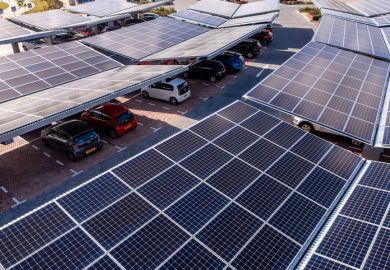UK universities’ carbon emissions fell by just a fraction last year because many institutions have already picked the “low-hanging fruit” of decarbonisation, according to a leading sustainability body.
Higher Education Statistics Agency data shows that the sector released 1.4 million tonnes of scope 1 and 2 carbon dioxide emissions in 2022-23.
Scope 1 emissions are from sources that an organisation owns or controls directly, and Scope 2 emissions are those an organisation causes indirectly.
A total of 118 providers have submitted data annually since 2015-16 and the latest figures show that total carbon emissions have fallen by 31 per cent since then. However, emissions across these providers are down just 1 per cent on last year, and 2 per cent on 2019-20.
Similar analysis last year showed that carbon emissions had fallen to their lowest level for at least six years, but academics warned that much more could still be done.
Charlotte Bonner, chief executive of the Alliance for Sustainability Leadership in Education, said it was inevitable that institutions’ reported carbon emissions will go up and down because of global socio-economic factors and campus use changes post-pandemic.
“What’s critical is the overall downward trajectory and that institutions are able to set and achieve ambitious carbon reduction,” she added.
“Many higher education institutions have been working on decarbonisation for decades. This means in many cases the ‘low-hanging fruit’ has been picked and the investments needed for the next step change in reductions come at a time of significant financial pressure for the sector.”
On an institutional level, 43 per cent of providers reduced emissions over the last year, compared with 33 per cent last year and 53 per cent two years ago.
Some universities reported significant increases in emissions year-on-year – including the University of Derby (39 per cent) and the University of the West of Scotland (34 per cent).
And one institution, Bishop Grosseteste University, recorded more emissions in 2022-23 than in 2015-16.
But the University of Edinburgh was the largest emitter in the sector for the sixth year in a row, releasing 62,000 tonnes of CO2 last year. It was followed by the University of Manchester (53,000), and Imperial College London (51,000).
Ms Bonner said the sector had demonstrated a collective commitment to decarbonising, and while some institutions are leading the way, others are “lagging behind the curve”.
“Policy consistency to support decarbonisation not just in HE but across the education sector and broader society is needed so that decarbonisation, as well as the sustainability agenda more holistically, stays on the agenda and we raise the bar so that all institutions can set and achieve ambitious decarbonisation goals,” she added.
The data shows that about 95 per cent of the sector’s emissions came from a combination of grid electricity and natural gas over the past eight years – but the balance has shifted slightly.
Emissions from grid electricity had been falling quite rapidly between 2015-16 and 2020-21, but have since risen again in the past two years. At the same time, the reverse is true for natural gas.
Register to continue
Why register?
- Registration is free and only takes a moment
- Once registered, you can read 3 articles a month
- Sign up for our newsletter
Subscribe
Or subscribe for unlimited access to:
- Unlimited access to news, views, insights & reviews
- Digital editions
- Digital access to THE’s university and college rankings analysis
Already registered or a current subscriber?







